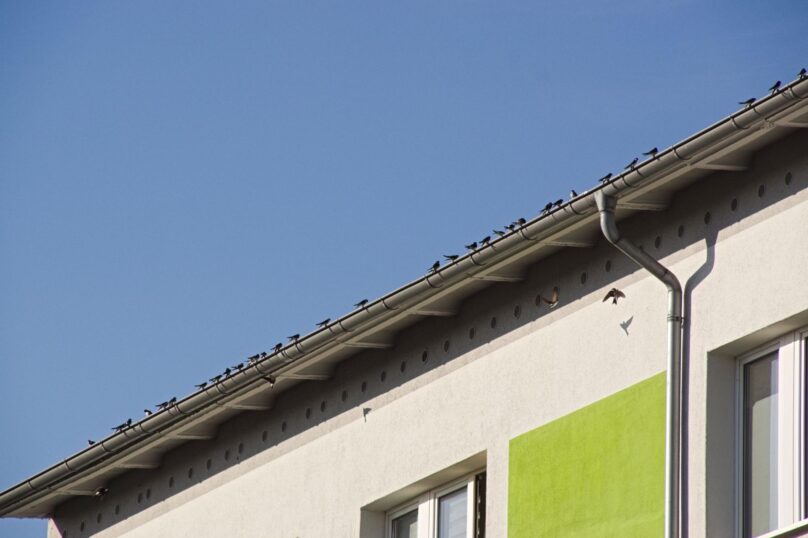How to Repel Birds Effectively

Birds and bats often become a costly nuisance for commercial properties. They create safety hazards, damage buildings, and spread contaminants. Traditional deterrents frequently fail because birds adapt quickly to ineffective methods. Business owners need long-term strategies that provide accurate results. Understanding the most effective bird control solutions is the first step in protecting your property.
How to Repel Birds With Physical Deterrents
Physical deterrents create barriers that prevent birds from roosting and nesting. They are among the most reliable solutions because they directly block access to problematic areas. Many commercial buildings use these methods to keep birds off ledges, rooftops, and other structures. Installing the proper physical deterrents ensures birds do not return. Here are the most effective physical barriers for bird control:
Bird Netting for Large Commercial Spaces
Bird netting prevents birds from entering large open spaces like warehouses, hangars, and parking garages. It works by creating an impenetrable barrier that stops birds from nesting. The material is durable and weather-resistant and can last years with proper installation. Businesses use this method because it keeps birds out without harming them. Choosing the right netting strength ensures long-term effectiveness.
Spikes and Wire Systems for Ledges and Signs
Spikes prevent birds from perching on ledges, signs, and beams. They make surfaces uncomfortable without injuring birds, keeping them away from key areas. Wire systems provide a similar function by creating unstable surfaces that birds avoid. These solutions work well for office buildings, hotels, and retail spaces. Proper installation ensures complete coverage of problem areas.
Electric Track Systems for Persistent Infestations
Electric track systems use low-voltage shocks to deter birds. The shock is harmless but conditions birds to avoid the area. These systems are helpful in places where birds continually return despite other deterrents. They are commonly installed on rooftops, ledges, and signage. This method provides a lasting solution for properties struggling with ongoing bird problems.
How to Repel Birds With Visual and Sound Deterrents
Birds use their senses to assess threats, and visual or auditory deterrents can trigger their flight response. These methods disrupt birds’ perception of safety and force them to seek other locations. Businesses use these deterrents to reinforce other control measures. While not consistently effective on their own, they enhance physical deterrents. Here are some of the most practical options available:
Reflective Devices and Decoys
Reflective tape, spinning discs, and balloons confuse and frighten birds. These items create unpredictable movements and flashes of light that deter unwanted flocks. Predator decoys like owl or hawk models also scare smaller birds away. However, frequent repositioning is necessary to maintain effectiveness. Many businesses use these methods in parking lots, loading docks, and rooftops.
Ultrasonic and Bio-Acoustic Systems
Ultrasonic systems emit sounds that disturb birds but remain inaudible to humans. Bio-acoustic systems play distress calls, making birds believe danger is present. These deterrents disrupt normal bird behavior, preventing nesting and roosting. They work best in warehouses, factories, and other large buildings. Combining them with physical deterrents increases long-term success.
How to Repel Birds With Chemical Repellents
Chemical repellents change how surfaces feel, taste, or smell to discourage birds. These solutions prevent birds from landing and nesting in unwanted areas. They work well in locations where physical barriers are impractical. Businesses use them to protect high-traffic areas from infestations. Below are some of the most effective chemical deterrents:
Gel and Liquid Repellents for Surfaces
Gel repellents create a sticky, unpleasant surface that birds avoid. Liquid sprays produce odors or tastes that birds find offensive. Both types deter birds from ledges, railings, and window sills without harming them. These methods require periodic reapplication to remain effective. They work best when combined with physical barriers.

Fogging Systems for Large-Scale Protection
Fogging systems release a harmless but irritating mist that drives birds away. This method covers large spaces efficiently and discourages birds from returning. Warehouses, stadiums, and transportation hubs often use fogging for long-term protection. Regular treatments help reinforce bird deterrence. When used correctly, fogging creates an unwelcoming environment for flocks.
How to Repel Birds by Eliminating Attractants
Birds are drawn to locations that offer food, water, and shelter. Removing these attractants is an effective way to deter infestations. Business owners should regularly inspect their properties for potential problem areas. When attractants are eliminated, birds are less likely to return. These strategies help reduce bird presence before infestations occur:
Waste Management and Food Control
Unsecured trash bins attract pigeons, seagulls, and other nuisance birds. Commercial properties must use sealed containers and schedule frequent waste removal. Outdoor eating areas should be cleaned immediately after use. Even small food crumbs can draw flocks of birds to a location. Reducing food availability forces birds to look elsewhere for sustenance.
Water Source Reduction
Standing water provides drinking and bathing spots for birds. Businesses must check drainage systems and eliminate rooftop puddles. Leaking pipes or HVAC systems should be repaired immediately. Reducing water sources makes commercial properties less appealing to birds, and a dry environment discourages long-term nesting.
Nesting and Roosting Prevention
Birds return to previous nesting spots year after year. Businesses should conduct routine inspections to identify problem areas. Removing nests before eggs hatch prevents permanent infestations. Blocking access to ledges, vents, and rafters stops birds from roosting. Preventive measures ensure commercial spaces remain bird-free.
How to Repel Birds With Professional Solutions
Commercial properties require long-term bird control solutions. Many DIY methods fail because birds adapt quickly. Professional bird control services provide expert solutions that work. Businesses benefit from specialized strategies tailored to their specific needs. Below are the advantages of working with bird control experts:
Commercial-Grade Bird Control Systems
Industrial-grade bird deterrents outperform consumer products. They can withstand harsh weather and high-traffic environments. Professional installation ensures complete coverage of problem areas. These solutions last longer and require less maintenance over time. Investing in quality deterrents saves businesses money in the long run.
Custom Bird Control Plans
Every commercial property has unique bird control challenges. Professional assessments identify the best solutions for each site. Experts develop customized plans to target specific problem areas. A tailored approach increases the effectiveness of bird deterrents. Businesses that invest in expert services achieve better results.

How to Repel Birds While Staying Legally Compliant
Many bird species are protected by law, requiring businesses to follow specific regulations. Failing to comply with wildlife protection laws can result in legal consequences. Professional bird control services help ensure enterprises operate within legal guidelines. Business owners must stay informed about restrictions before attempting any removal efforts. Below are key legal considerations when implementing bird control measures.
Understanding Protected Bird Species
Certain bird species are federally and regionally protected. Removing or harming these birds without permits can lead to penalties. Businesses must identify which species are legally off-limits. Consulting wildlife agencies ensures compliance with local laws. Professional services can provide expert guidance on legal bird control.
Approved Bird Control Methods
Not all bird deterrents are legally permitted. Some methods, like poison or lethal traps, may be restricted. Businesses must use humane and approved deterrents such as netting, spikes, and sound devices. Regulations vary by region, making professional consultation essential. Ensuring compliance prevents legal risks and public backlash.
Working With Certified Bird Control Experts
Licensed professionals understand the legal landscape of bird control. They ensure businesses follow ethical and legal removal procedures. Experts provide customized strategies that align with wildlife laws. Using professional services reduces the risk of accidental violations. Businesses benefit from long-term, legally compliant bird control solutions.
How to Adjust Strategies to Repel Birds Effectively
Bird behavior changes throughout the year, requiring seasonal adjustments to deterrent methods. Nesting season increases infestations in spring, while food sources attract birds in summer. Migratory birds pose challenges in fall, and winter conditions drive flocks into sheltered areas. Businesses must adapt their bird control measures based on seasonal activity. Below are the best seasonal bird control strategies:
Spring: Nesting Prevention Strategies
Spring is peak nesting season, making prevention a priority. Blocking access to nesting sites before birds lay eggs is essential. Regular inspections help identify early signs of nesting activity. Removing nests at the onset prevents long-term infestations. Physical barriers like netting and spikes deter birds from roosting.
Summer: Managing Food and Water Sources
Warm weather increases bird activity around food and water sources. Outdoor dining areas, trash bins, and drainage systems attract birds. Businesses should enforce strict waste management and eliminate standing water. Sealing garbage containers reduces food availability. Keeping commercial spaces clean discourages birds from lingering.
Fall: Controlling Migratory Bird Activity
Fall brings temporary bird surges as species migrate. Birds seek resting spots during their journey, leading to seasonal infestations. Reflective deterrents and sound devices help disrupt migratory patterns. Installing additional deterrents during peak migration times strengthens protection. Seasonal adjustments ensure properties remain bird-free year-round.
Winter: Preventing Indoor Roosting and Nesting
Cold temperatures drive birds to find shelter in warm structures. Businesses should inspect rooftops, vents, and loading docks for entry points. Blocking gaps and sealing openings prevents birds from nesting inside buildings. Regular maintenance keeps birds from settling indoors. Early action reduces the risk of long-term infestations.
How to Repel Birds and Safeguard Your Property
Ignoring bird infestations only leads to more significant problems—damage, health risks, and ongoing costs. A well-planned bird control strategy is not an option; protecting your business is necessary. Every day you wait, birds become more comfortable, making removal even more complicated. The most effective solutions are proactive, targeted, and professionally implemented. Now is the time to invest in reliable bird deterrents and reclaim your property before the problem takes flight.
Bird problems don’t wait—neither should you! Visit the Elite Bird Management blog for industry insights and expert bird control solutions.




